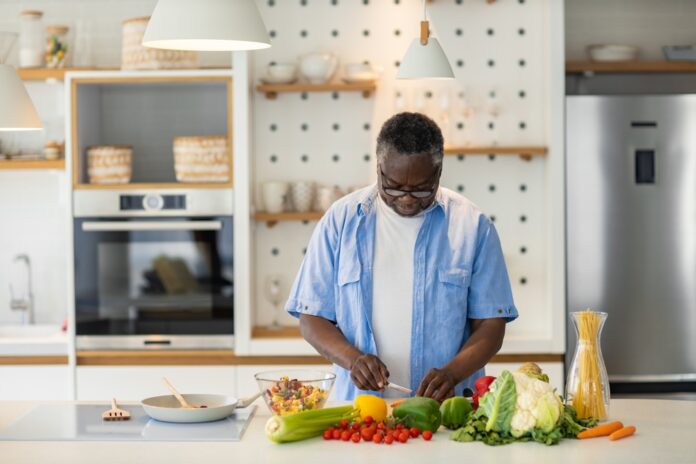Especially when you’re new to diabetes, finding diabetic recipes for seniors can seem like a minefield. Between balancing blood sugars and avoiding “off limits” foods, it can be difficult to understand which items qualify as diabetes-friendly.
But many of the meals you already eat can become blood sugar-stabilizing with a few subtle ingredient swaps! Read on to discover diabetes favorites new and old, plus tips for healthier cooking.
What Are Senior Diabetic Recipes?
Diabetic-friendly recipes generally contain added sugars, refined grains, and saturated fat to promote balanced blood sugar levels and overall health. They are considered carb-conscious, meaning they contain carbohydrates or foods that land lower on the glycemic index—a system used to measure and rate carbohydrate-containing foods.
Why Are Diabetes-Friendly Recipes Important?
People with diabetes struggle to use insulin, a hormone crucial to balancing blood sugar, sometimes even with the help of medication. Diabetes-friendly recipes are an integral part of treatment because certain nutrients can help stabilize the amount of sugar that stays in the bloodstream.
Overall, you want to find a nutritional balance so blood sugars don’t rapidly spike and drop. So, finding the right recipes and planning the right portions can enhance your quality of life.
Diabetic Recipes for Seniors: Breakfast
Skipping breakfast can be especially harmful for diabetic seniors since the morning meal often helps to even out blood sugars after waking from sleep. A meal complete with protein, fiber, and healthy fats can also help curb mid-morning cravings and carry you until lunchtime! Explore the following ideas for breakfast inspiration.
Protein Smoothies
As mentioned above, protein-rich meals are important for people managing diabetes. And since blood sugar can peak in the morning, an occurrence called the dawn phenomenon, an earlier meal with protein is key to balancing blood sugar.
Considered one of the top nutrition drinks for seniors, breakfast smoothies or shakes with a boost of protein powder can be beneficial for many reasons. Beyond being easier for the body to digest, protein-rich smoothies can help calorie-deficient seniors get closer to their goals.
Protein takes longer to digest and slows the absorption of carbohydrates, so it’s also ideal for promoting a feeling of fullness. Alongside resistance training, protein also helps seniors maintain muscle mass during aging.
Yogurt Bowls or Parfaits
Move over cereal… There’s a new favorite breakfast bowl in town! Yogurt bowls and parfaits have three main components: a base layer of yogurt, a middle layer of fresh fruit, and a top layer of desired toppings—like granola, nuts, seeds, and dried coconut flakes.
For diabetics, Greek yogurt may be the best option because of its exceptional amount of protein. It’s also wise to avoid added sugars in the toppings and check the label of pre-packaged items like granola for grams of sugar included. A drizzle of honey or a sprinkle of cinnamon may be all you need to add a note of sweetness!
Oatmeal or Overnight Oats
Enjoy breakfast, but don’t want to put in effort in the early hours? Overnight oats are a low-maintenance solution since they can be mixed the night before and eaten first thing in the morning. Packed with fiber, overnight oats can help promote a feeling of fullness while preventing spikes in blood sugar.
A bowl of warm oatmeal is another excellent option, especially when the weather begins to cool. Smart toppings—such as nuts and seeds—add blood sugar-stabilizing healthy fats while delivering flavor.
Diabetes-Friendly Recipes for Seniors: Lunch
Lunch is equally as important as breakfast to help avoid a mid-afternoon crash when blood sugars dip lower than normal. A filling and fueling lunch can help seniors stay full until dinner and prevent overeating at the evening meal.
Leafy Green Salad
As part of a popular diabetes eating technique called “the plate method,” filling at least half your plate with non-starchy vegetables is often recommended. A leafy green salad goes above and beyond by covering the whole plate in leafy greens and then layering on delicious toppings. Try incorporating fruits and vegetables of different textures—such as dried cranberries and sliced squash—to make it more interesting.
Remember that anything with added sugar, such as candied nuts or salad dressings, may cause a rise in blood sugar. It’s best to check the nutrition facts label of your salad ingredients before purchase, or simply make dressings and toppings at home.
Mason Jar Salads
Need a go-to or on-the-go—solution for lunch? Mason jar salads have you covered as a healthy and easy lunch idea.
Utilizing layered ingredients, mason jars are visually beautiful and incredibly tasty, and nearly any salad you make can be converted into a mason jar salad. Just be sure to layer more moist ingredients towards the bottom while the drier ones sit at the top.
Bean or Lentil Soup
Beans and lentils are high in fiber and plant protein—two nutrients diabetic seniors may need to increase in their diet—so bean- or lentil-based soups are great lunchtime options. Plus, using bone broth as a base may help increase the amount of vitamins and minerals.
Diabetes Recipes for Seniors: Dinner
Don’t leave dinner out of your diabetic meal plan! Making smart dinnertime decisions may impact your blood sugar levels the next morning since research suggests large, carb-heavy dinners may provoke worrisome peaks in blood sugar at dawn.
Our thoughtful dinner selections can also help prevent late-night snacking, which can cause confusion when it comes to measuring and administering medication appropriately.
Lightened Up Lasagna
Lasagna often has a bad reputation among diabetic older adults and is commonly considered “off limits” thanks to layers and layers of pasta noodles. However, a couple of subtle switches can lighten up this classic dinner dish.
Simply swap plain lasagna noodles for wheat ones, and increase the veggies you add between layers for a delicious, nutritious dinner. Pairing with a side salad or cooked veg can also enhance the meal’s nutritional value.
Brown Rice Bowls
Switch up your basic chicken breast and brown rice routine to create brown rice bowls! Using a small amount of brown rice as a base, layer on toppings rich in vitamins, minerals, protein, fiber, and healthy fats.
Popular bowl ingredients include chicken, black beans, broccoli, carrots, or onions. As a bonus, you can add a sauce with spicy ingredients to spice things up (and possibly help you live longer)!
Crockpot Chili
A favorite among young and older crockpot enthusiasts alike is cooking chili in a crockpot. Full of protein- and fiber-rich ingredients like beans, a good bowl of chili is hard to beat when hunger strikes in the evening.
Chili can also be made leaner (or vegetarian) by replacing the meat ingredients with more vegetables and beans.
Diabetic-Friendly Recipes for Seniors: Snacks
Snacking is often villainized as an unhealthy way to gain weight. However, snacking has its benefits when seniors select healthy choices. Choosing a diabetic-friendly snack can prevent blood sugar from rising too high or dipping too low between mealtimes.
Popcorn
Did you know that popcorn is a whole grain? Although surprising, popcorn falls in the whole grain category, making it a delicious and nutritious snack! Plain, unflavored varieties are usually best, although homemade seasoning mixes—with little to no added salt or sugar—can enhance flavor.
Homemade Trail Mix
If you’re looking for a protein-packed snack, trail mix is a portable option. Especially for diabetic individuals, homemade recipes are preferred. Store-bought varieties can be high in added sugars and skyrocket blood sugars.
Hard-Boiled Eggs
Another high-protein snack worth considering is the humble hard-boiled egg. Eggs contain plenty of protein, and hard-boiled eggs can be another portable option for adventure-prone seniors.
If they don’t get eaten as a snack, use them for egg salad sandwiches as a last-minute meal.
Veggies and Hummus
Hummus is made from chickpeas, making it incredibly high in protein compared to other vegetable dips. Thanks to its protein content, hummus will fill you up while providing nutrients needed among members of the senior population.
Pairing hummus with pre-cut vegetables—like baby carrots, celery, or bell peppers—is the ultimate winning combination. It can also be enjoyed alongside a meal, like lunch, to make it more hearty.
Cooking Tips for Seniors with Diabetes
Cooking and preparation methods also matter when it comes to planning a diabetes diet. The following tips can help guide you in your efforts.
Aim For Variety
A popular philosophy among diabetic cooks is to “eat the rainbow.” The goal is to include various foods, especially fruits and vegetables, of all shapes and sizes. It sounds simple, but it is a tactic that can encourage elderly eaters to meet their nutrient needs while creating a more colorful, appetizing plate.
Choose Cooking Oils, Condiments, and Seasonings Wisely
Beyond sugar’s ability to aggravate diabetes, ingredients high in salt or saturated fat can hurt heart health—which is related to diabetes risk. The healthiest meals can be sidelined by condiments and toppings, which often include sneaky sources of added sugar and salt.
Be sure to check the labels on your condiments and seasoning blends, and opt for heart-healthy cooking oils (like canola or olive oil) when possible.
For Seniors Short On Time
If the above meals sound too much, it may be worth considering a meal delivery service. Many programs—such as Silver Cuisine—offer diabetic-friendly meals delivered to your door.
These meals may be able to help you manage your diabetes better by allowing you to enjoy expert-designed meals without all the fuss of cooking or preparing them yourself.
Diabetic Recipes for Seniors: Final Takeaways
Although diabetes may cause you to rethink some of your favorite classic recipes, there are plenty of options. From breakfast to dinner, think of protein, healthy fats, and fiber when creating your meal to make it more filling.
Also, avoid blood sugar spikes or crashes by carefully selecting snacks that keep you fueled. When in doubt, reach out to your diabetes care team or dietitian, and aim to “eat the rainbow!”






